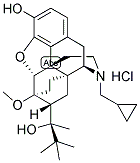
BUPRENORPHINE HYDROCHLORIDE
- русский язык имя
- английское имяBUPRENORPHINE HYDROCHLORIDE
- CAS №53152-21-9
- CBNumberCB5140046
- ФормулаC29H41NO4.ClH
- мольный вес504.1
- EINECS258-396-8
- номер MDLMFCD04037215
- файл Mol53152-21-9.mol
| Температура плавления | 260-262?C (dec.) |
| температура хранения | -0°C |
| растворимость | Sparingly soluble in water, freely soluble in methanol, soluble in ethanol (96 per cent), practically insoluble in cyclohexane. |
| форма | Powder |
| Растворимость в воде | Soluble to 25 mM in water and to 50 mM in ethanol |
| Словарь онкологических терминов NCI | buprenorphine hydrochloride |
| FDA UNII | 56W8MW3EN1 |
| Коды опасности | Xn,T,F | |||||||||
| Заявления о рисках | 22-62-63-39/23/24/25-23/24/25-11 | |||||||||
| Заявления о безопасности | 26-36-45-36/37-16-7 | |||||||||
| WGK Германия | 3 | |||||||||
| RTECS | KM7758000 | |||||||||
| кода HS | 2939110000 | |||||||||
| NFPA 704: |
|
рисовальное письмо(GHS)
-
рисовальное письмо(GHS)


-
сигнальный язык
предупреждение
-
вредная бумага
H302:Вредно при проглатывании.
H361:Предполагается, что данное вещество может отрицательно повлиять на способность к деторождению или на неродившегося ребенка.
-
оператор предупредительных мер
P201:Беречь от тепла, горячих поверхностей, искр, открытого огня и других источников воспламенения. Не курить.
P202:Перед использованием ознакомиться с инструкциями по технике безопасности.
P264:После работы тщательно вымыть кожу.
P270:При использовании продукции не курить, не пить, не принимать пищу.
P281:Пользоваться надлежащим индивидуальным защитным снаряжением.
P301+P312:ПРИ ПРОГЛАТЫВАНИИ: Обратиться за медицинской помощью при плохом самочувствии.
P308+P313:ПРИ подозрении на возможность воздействия обратиться за медицинской помощью.
P405:Хранить в недоступном для посторонних месте.
P501:Удалить содержимое/ контейнер на утвержденных станциях утилизации отходов.
BUPRENORPHINE HYDROCHLORIDE химические свойства, назначение, производство
Описание
Buprenorphine (hydrochloride) (CRM) (Item No. ISO60178) is a certified reference material that is structurally categorized as an opioid. It is a partial agonist of the μ-opioid receptor (Ki = 4.18 nM) that less potently acts at δ- and κ-opioid receptors (Kis = 25.8 and 12.9 nM, respectively). Buprenorphine is used, alone or with naloxone (Item Nos. ISO60194 | 15594), to counter opiate addiction. This product is intended for research and forensic applications.Химические свойства
White SolidИспользование
Controllled substance (narcotic). Analgesic that demonstrates narcotic agonist-antagonist properties.Определение
ChEBI: The hydrochloride salt of buprenorphine.Приобретенная устойчивость
Buprenorphine is 20 to 50 times more potent than morphine in producing an ED50 analgesic effect in animal studies; however, it cannot produce an ED100 (compared to morphine) in these tests. Thus, buprenorphine is a potent partial agonist at μ opioid receptors. It also is a partial agonist at κreceptors but more of an antagonist at δ receptors. Buprenorphine, at 0.4 mg intramuscular dose, will produce the same degree of analgesia as 10 mg of morphine. Because of its partial agonist properties, it has a lower ceiling on its analgesic action but also produces less severe respiratory depression. It is incapable of producing tolerance and addiction comparable to full μ agonists. In fact, buprenorphine's partial agonist action, very high affinity for opioid receptors, and high lipophilicity combine to give buprenorphine a tolerance, addiction, and withdrawal profile that is unique among the opioids. When given by itself to opioid-naive patients, little tolerance or addictive potential (Schedule 5) is observed. A mild withdrawal can occur some 2 weeks after the last dose of buprenorphine. Buprenorphine will precipitate withdrawal symptoms in highly addicted individuals, but it will suppress symptoms in individuals who are undergoing withdrawal from opioids. It effectively blocks the effect of high doses of heroin. Because of these properties, buprenorphine has been approved for office-based use in treating opioid dependence. It also has been reported to suppress cocaine use and addiction.Биологическая активность
ORL 1 receptor agonist that also displays mixed antagonist/partial agonist activity at κ , δ and μ -opioid receptors.Клиническое использование
Buprenorphine undergoes extensive first-pass 3-O-glucuronidation, which negates its usefulness after oral dose. It is available in parenteral and sublingual dosage forms. The typical dose is 0.3 to 0.6 mg three times per day by intramuscular injection for analgesia or 8 mg/day as a sublingual tablet for opioid-dependence maintenance. The duration of analgesic effect is 4 to 6 hours. After parenteral dose, approximately 70% of the drug is excreted in the feces, and the remainder appears as N-dealkylated and conjugated metabolites in the urine. Naloxone is not an effective antagonist to buprenorphine because of the latter's high binding affinity to opioid receptors.